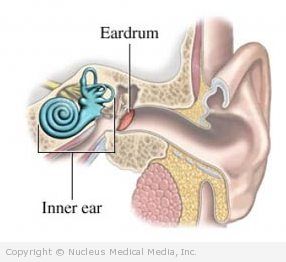(Otospongiosis)
Otosclerosis – Definition
Otosclerosis occurs when abnormal new bone forms in the inner ear. This growth prevents proper functioning of other ear structures. This condition is a common cause of hearing loss.
Otosclerosis – Causes
The cause of otosclerosis is still unknown. However, otosclerosis tends to run in families, and may be hereditary. Otosclerosis has also been linked to hormonal changes, especially pregnancy, and viral infections.
Otosclerosis – Risk Factors
A risk factor is something that increases your chance of getting a disease or condition. Risk factors for otosclerosis include:
- Age: late teens through late 40s
- Family history of otosclerosis
- Sex: female
- Race: Caucasian or Asian
- Drinking nonfluoridated water: Some studies suggest that nonfluoridated water may cause a susceptible person to develop otosclerosis
- Pregnancy: may accelerate symptoms
Otosclerosis – Symptoms
Gradual hearing loss is the main symptom of otosclerosis. Hearing loss may be of two types:
- Conductive — involving the small bones of the inner ear
- Sensorineural — involving the following structures:
- Cochlea — the sensory organ in the inner ear
- The major nerve pathway (8th cranial nerve) and/or area of the brain responsible for hearing
Early in the disease, you may first notice trouble hearing low-pitched sounds or whispers. Other symptoms may include:
- Dizziness
- Balance problems
- Tinnitus or sensation of ringing, roaring, or buzzing in the ear
Otosclerosis – Diagnosis
The doctor will ask about your symptoms and medical history, and perform a physical exam. Tests may include:
- Hearing tests by an audiologist
- Computed tomography (CT) scan — a type of x-ray that uses a computer to make pictures of the inside of the ear and head
- Examination of the middle ear at the time of surgery
Otosclerosis – Treatment
Treatments may include:
Hearing Aid
Hearing aids may be effective for conductive and sensorineural hearing loss.
Surgery
In many cases, a procedure called a stapedectomy may improve hearing. The purpose of this operation is to replace the diseased bone with an artificial device that can transmit sound waves to the inner ear. Stapedectomy is very effective and frequently returns hearing to a near normal level.
Oral Treatment
Fluoride tablets are sometimes prescribed to stabilize the condition and prevent further sensorineural hearing loss. However, this treatment remains controversial and unproven.
Otosclerosis – Prevention
Drinking fluoridated water may help prevent otosclerosis in people who are susceptible. There are no other known ways of preventing this condition.

